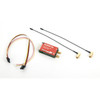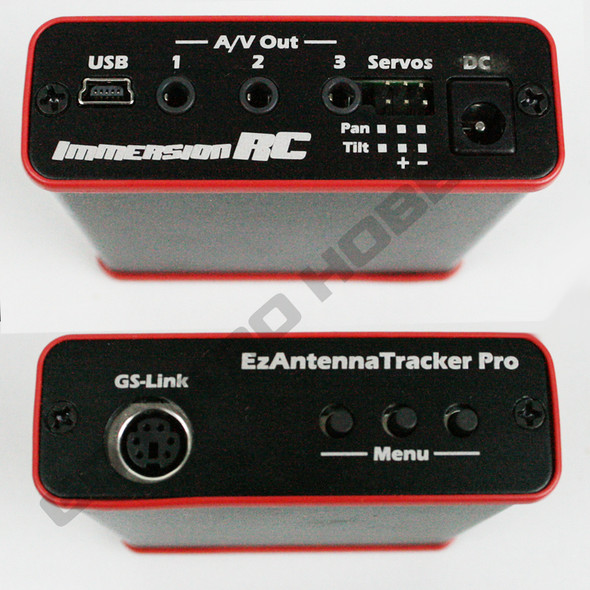Frequently bought together:
Description
The high-end receiver in the EzUHF family. 8x Servo Outputs, but 12 channel PPM capability.
Diversity antenna inputs to increase range, and reliability.
A Full Featured LRS
When 2.4GHz R/C systems run out of steam, UHF Long Range Systems are ready for more.
The EzUHF system has proven performance, and was used by the long-range FPV experts for their famous proximity flights.
Reliable FHSS Link (Frequency Hopping, Spread Spectrum)
-112dBm Sensitivity
Twin antenna inputs
SAW filtered input, eliminates nearby high-power video Tx interference
Multicopter mode, emits up to 12 channels of PPM on a chosen channel
8 standard servo connectors
USB port for future upgrades
Built-in Spectrum Analyzer
The only commercial LRS to include this essential feature; a built-in Spectrum Analyzer. This essential tool may be used to ensure that a model emits no interfering emissions on the UHF band, which could reduce range.
Plug in a standard USB cable, install the free ImmersionRC Tools, and create charts of power emitted on the UHF spectrum.
Arbitary Channel Mapping
Using the ImmersionRC Tools, the servo outputs of the EzUHF 8 channel Rx may be arbitrarily remapped to suit the target model.
Multicopter wiring may be greatly simplified using a single PPM cable, easily configured using the tools. Need PWM outputs to drive Pan/Tilt servos?, no problem using the tools.
Uplink Status (UPSTAT)
All uplink status is available in the single-cable PPM stream for use by supported OSDs. The XuGong v2/Pro, or the upcoming XuGong Vortex both take advantage of this method to show critical uplink status on-screen.
The received signal strength (RSSI) of each of the receiver’s antennas, along with the link quality, are captured by the OSD, and displayed with appropriate alarms to indicate marginal conditions.
NOTE: EzUHF Firmware v1.51 or later required to support single-cable UPSTAT.
Simple Failsafe
Setting the failsafe on the EzUHF is as simple as pressing a button on the back of the transmitter during flight.
Set your model into a gentle turn, drop the throttle, and set the failsafe. In the unlikely situation where the uplink is lost, the model will safely glide to the ground.
On a multicopter, the UHF failsafe will trigger the flight controller’s failsafe, and for most systems will start the RTH (Return to Home).
SPECIFICATIONS:
R/C Channels: Maximum of 12 PPM, 8 servo outputs (future upgrade to 16 PPM channels)
RF Impedance: 50 ohms
Modulation: GFSK
Hopping: 20 of 40 slots, 2MHz, or 20MHz frequency spread (Extreme Hopping)
Frequency Band (Std. Firmware): 431-433MHz, 433-435MHz, 435-437MHz, 436-438MHz, 430-450MHz (Extreme Hopping)
Frequency Band (UK Firmware): 459MHz
Length: 70mm
Width: 30mm
Height: 17mm
Weight: 22g
Power Requirements: 4-6v DC
View AllClose
Diversity antenna inputs to increase range, and reliability.
A Full Featured LRS
When 2.4GHz R/C systems run out of steam, UHF Long Range Systems are ready for more.
The EzUHF system has proven performance, and was used by the long-range FPV experts for their famous proximity flights.
Reliable FHSS Link (Frequency Hopping, Spread Spectrum)
-112dBm Sensitivity
Twin antenna inputs
SAW filtered input, eliminates nearby high-power video Tx interference
Multicopter mode, emits up to 12 channels of PPM on a chosen channel
8 standard servo connectors
USB port for future upgrades
Built-in Spectrum Analyzer
The only commercial LRS to include this essential feature; a built-in Spectrum Analyzer. This essential tool may be used to ensure that a model emits no interfering emissions on the UHF band, which could reduce range.
Plug in a standard USB cable, install the free ImmersionRC Tools, and create charts of power emitted on the UHF spectrum.
Arbitary Channel Mapping
Using the ImmersionRC Tools, the servo outputs of the EzUHF 8 channel Rx may be arbitrarily remapped to suit the target model.
Multicopter wiring may be greatly simplified using a single PPM cable, easily configured using the tools. Need PWM outputs to drive Pan/Tilt servos?, no problem using the tools.
Uplink Status (UPSTAT)
All uplink status is available in the single-cable PPM stream for use by supported OSDs. The XuGong v2/Pro, or the upcoming XuGong Vortex both take advantage of this method to show critical uplink status on-screen.
The received signal strength (RSSI) of each of the receiver’s antennas, along with the link quality, are captured by the OSD, and displayed with appropriate alarms to indicate marginal conditions.
NOTE: EzUHF Firmware v1.51 or later required to support single-cable UPSTAT.
Simple Failsafe
Setting the failsafe on the EzUHF is as simple as pressing a button on the back of the transmitter during flight.
Set your model into a gentle turn, drop the throttle, and set the failsafe. In the unlikely situation where the uplink is lost, the model will safely glide to the ground.
On a multicopter, the UHF failsafe will trigger the flight controller’s failsafe, and for most systems will start the RTH (Return to Home).
SPECIFICATIONS:
R/C Channels: Maximum of 12 PPM, 8 servo outputs (future upgrade to 16 PPM channels)
RF Impedance: 50 ohms
Modulation: GFSK
Hopping: 20 of 40 slots, 2MHz, or 20MHz frequency spread (Extreme Hopping)
Frequency Band (Std. Firmware): 431-433MHz, 433-435MHz, 435-437MHz, 436-438MHz, 430-450MHz (Extreme Hopping)
Frequency Band (UK Firmware): 459MHz
Length: 70mm
Width: 30mm
Height: 17mm
Weight: 22g
Power Requirements: 4-6v DC























